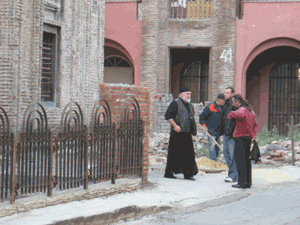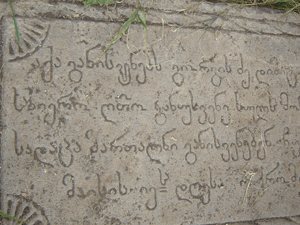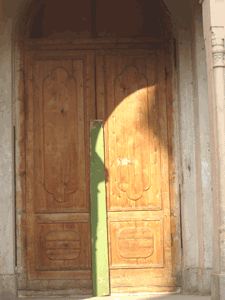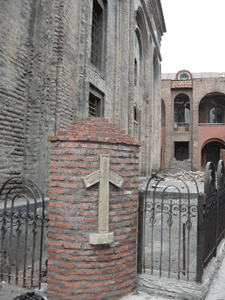 Nona Suvarian, Tbilisi Nona Suvarian, Tbilisi
The
situation became tensed about the Church of St. Norasheni located in
Leselidze str. in Tbilisi. There are two churches in one yard-Church of
St. Norasheni and Orthodox Church of Cross Father. On November 16,
father Tariel (Sikinchelashvili), the clergyman of the Orthodox Church
intended to remove the grave stones of two Armenian Patrons in the yard
and it resulted in a great uproar.
Georgia based Eparchy
of Armenian Apostolic Church spread press-release which states that
Church of St. Norasheni was built in the XV century and it belonged to
the Armenian Eparchy since it foundation. However, the church lost its
function in the 1930s and was used as storage for books. After Georgia
gained independence from the Soviet Union, the Georgian government
decided to not return the Church of St. Norasheni to Armenian Apostolic
Church.
Humanrights.ge
interviewed Father Davit Sharashenidze, the head of the Press Center of
the Georgian Patriarchate. He did not say anything new about the
foundation of the church. However, he pointed out that historians
should discuss who are the actual owners of the church.
The source of the
problem is that two churches are located in one yard and only the
Orthodox Church functions. All activities carried out in the common
yard is initiated by Father Tariel Sikinchelashvili.
Mikheil
Avagian, head of the Department for Culture, Youth and Education within
the Eparchy of Armenian Apostolic Church in Georgia: “Father
Tariel Sikinchelashvili started to change the architectural face of the
Armenian Church since 1995; he changed those features that proved that
the church was Armenian. He withdrew religions writings and removed
items from the altar.
In 2005, Tariel Sikinchelashvili brought grave stones to the yard of the church of St. Norasheni from a strange place and put
them at the walls of the church. The text on the grave stones starts
with the following words: “Here lies…” That means, there must be graves
under those stones. However, there are many witnesses who can confirm
that these stones were only brought here several years ago.”
the yard of the church of St. Norasheni from a strange place and put
them at the walls of the church. The text on the grave stones starts
with the following words: “Here lies…” That means, there must be graves
under those stones. However, there are many witnesses who can confirm
that these stones were only brought here several years ago.”
“Tariel
Sikinchelashvili started to surround the yard with the fence that is
decorated with the attributes of Georgian Orthodox Church. Tbilisi City
Hall and Patriarchate decided to dismantle this fence but it is still
being constructed. Officials from the City Hall state that Tariel
Sikinchelashvili stands in the way of carrying out their decision.
Moreover, he has boarded up the door of  the Armenian Church.” the Armenian Church.”
Naturally the
situation was not well received by both local Armenians – not to
mention the reaction in Armenia. Armenian Eparchy expressed its concern
regarding another fact of planned appropriation of the religious
property and described the fact as violation of the agreement from
Georgian side.
According to the news
agency “Kavkaspress” on November 21 Vagram Melikian, the head of the
Press Center of the Armenian Apostolic Church, stated at the
press-conference in Yerevan, that vandalism acts occur in Georgia
because of carelessness of Georgian Orthodox Church. Neither the
negotiations between Garegin II, Catholicos of Armenia and Ilia II,
Patriarch of Georgia have had any results.
“Georgia follows the
way of Turkey and suggests Echmiadzin to establish commission that will
investigate which church is Georgian or Armenian in Tbilisi. It is
unacceptable for us because we have valid proofs that so-called
disputable churches are actually Armenian,” said Vagram Melikian.
According to the same
news agency several days ago the issue of the Church of St.Norasheni
was discussed on a high-political level. Ovik Abramian, speaker of the
Armenian Parliament, is sure that Georgian authority will punish the
perpetrators. He discussed the problem with Georgian Ambassador to
Armenia. Revaz Gachechiladze, the ambassador, stated that he met
Armenian clergymen and authorities from the Georgian government. He is
sure that Georgian authorities will take all appropriate measures to
punish the perpetrators.
On the other side,
Father Davit (Sharashenidze) denies that facts of vandalism occurred
and states that in fact the situation is completely different. He
thinks this is artificially created problem that has not connection
with the reality.
Fatehr Davit (Sharashenidze):
“In the past it was rubbish damp and a shelter for tramps. Today, this
place is clean and by the way, no stone was removed from there.”
“There is Georgian
church also lies within the yard. This fence belongs to the Orthodox
Church and it is natural that there are Georgian crosses on the fence
because we are in Georgia. Thousands of lawless events have happened in
the yard but Armenian side has never complained about such deeds. Since
Georgian side started to arrange a square there and planted trees and
paved the streets, they started to complain. If this church will be
transferred to the Armenian Church it will be decorated at least.”
Davit Sharashenidze
denies the claiming of Avagiani who said that grave stones were brought
to the yard several years ago. Sharashenidze said that these stones
have always been there and there are graves under them.
As for the door of the church it was nailed shut by the government.
Father Davit (Sharashenidze):
“This is disputable church. There are remains of Georgian religious
symbols there as well. Until we can finally decide which side this
church belong to, the current situation will not change. Historians
must be settled this matter. As far as I know, Georgian patriarchate
and Armenian delegation have had some negotiations. There are several
churches in Armenia that belong to Georgian Orthodox Church. We have
almost the same kind of complaints with Armenian Church as they have
with us. There are Georgian churches in Armenia that were changed and
transformed by Armenian Catholics. Georgian side complained about it
but nobody paid attention to their complaints from Armenian side. Then
they started argument about Norasheni.”
Expert Nugzar Papuashvili stated that the controversy between two churches might turn into the conflict between the countries.
Nugzar Papuashvili:
“At this stage similar activities are nothing more but provocation. I
do not know whether the initiators of the activities are aware what  they
are in fact doing. Anyway, the result might turn out extremely bad. In
addition, there is no legal basis for this initiative. The church
building belongs to the state and not to any church. However,
historical links of this church belong to Armenians. They say it was
Orthodox Church in the past. It should be investigated because nothing
is excluded. However, it is fact that when Georgia was occupied by
Soviet Union and they started to close down churches, this particular
church belonged to the Armenian Church. In addition, it is constructed
in an Armenian style. they
are in fact doing. Anyway, the result might turn out extremely bad. In
addition, there is no legal basis for this initiative. The church
building belongs to the state and not to any church. However,
historical links of this church belong to Armenians. They say it was
Orthodox Church in the past. It should be investigated because nothing
is excluded. However, it is fact that when Georgia was occupied by
Soviet Union and they started to close down churches, this particular
church belonged to the Armenian Church. In addition, it is constructed
in an Armenian style.
The logic is the following:
since Norasheni Church is in the yard of Georgian Orthodox Church and
it is claimed that no other church should be in the yard of the
Orthodox Church, Norasheni Church should also belong to us. Although
the Georgian Patriarchate hinders the process, Tariel Sikinchelashvili,
the initiator, is a clergyman and consequently under his charge. In the
end it is the Patriarchate that is responsible for his activities. This
situation in fact started since April 9 1989 (day of National Movement
in Georgia when about 20 young demonstrators were killed by Russian
troops in Tbilisi). Georgian authority then occupied churches that
previously belonged to various religious affirmations in Georgia.
There is similar stigma facing many in Georgian society: Who is not Orthodox is considered an enemy of national interests.”
Father Davit
(Sharashenidze) states that there is no tension between Georgian and
Armenian churches. Just the opposite they have perfect relationships.
Father Davit:
“Armenian Catholicos Garegin visited Georgia and after that Georgian
Patriarch visited Armenia too. Such kinds of problems should not impact
on relation between the two religions.”
St. Norasheni is not
the only disputable church in Tbilisi. There are other five churches in
the capital that do not have a clear owner as yet. The commission that
was set up to resolve this problem is not yet functioning. While the
problem cannot be resolved without active work and to carefully
consider the interests of both parts of the controversy.
2008 11 29
|